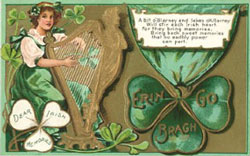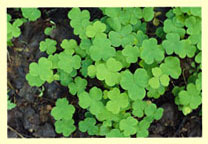|
Ireland's Shamrock LegendReady to sort out the facts from the fantasy of the Shamrock Legend?
(I wonder who originally wrote those paragraphs, anyway?) But I know you want to know more. I know you're tired of reading the same words about St. Patrick and shamrocks over and over again. Well, you came to the right place! How do I know? Because even though I won't leave out the basics you find everywhere else, I can relate that basic information to you in my own words, and I can (and will) reveal even more about the shamrock legend than you will find anywhere else. You are about to discover that Fantasy-Ireland is the only source you need for learning about all your favorite Irish symbols! Why? Because the shamrock is one of the best representations of the Fantasy Ireland! And it is my job to honor your fantasy of Ireland, but also to help you sort out fact from fantasy. You count on me to honor your fantasies, but also give to you the facts. So you can decide for yourself what the shamrock legend means to you.
After all, the shamrock is without a doubt the most universally recognized symbol of Ireland. It has such power to define Ireland in the minds of people that it is used in the official logos of many major Irish organizations, like Fáilte Ireland, the Irish Tourist Board, for example. It is also the emblem of the official airline of Ireland, Aer Lingus. Every year on St. Patrick's Day, Aer Lingus flies freshly cut shamrock to the Irish embassies all over the world so that Irish diplomats and uniformed personnel can uphold the "Wearing of the Green" tradition on their beloved National Holiday. Fact vs. FantasyMany sites will tell you that the little trefoil known as the shamrock was once known as "seamróg", pronounced "Seamroy", meaning "little clover". They also mention the fact that it is a very common clover that grows heartily in Ireland. Many agree that the ancient Druids honored it as a sacred plant. The Druids believed the shamrock had the power to avert evil spirits. Some people still believe the shamrock has mystical, even prophetic, powers. It is said that the leaves of shamrocks turn upright whenever a storm is coming. According to Lady Wilde, the shamrock "enlightens the brain and makes one see and know the truth". The ancient Irish Celts also revered the shamrock because it has three leaves, and they considered "3" to be a sacred number. The ancient Celtic Druids believed many numbers held mystical powers. The three leaves shaped like hearts were associated with the Triple Goddess of Celtic mythology, otherwise known as the "Three Morgans". The Triple Goddess represented the Triple Mothers, the hearts of the ancient Celtic tribes. This Celtic tradition of honoring "3's" continued in Ireland for millennia.
Three was also sacred to devotees of the goddess, Brighid, signifying totality. And the Irish bards continued the significance of "3's" by using triple repetition in their storytelling rhythms. Actually, many spiritual belief systems, ancient and contemporary, find the number "3" to have mystical properties. The shamrock was considered a sacred plant to ancient Iranians, for example. They knew it as "shamrakh" and honored it as a symbol of the Sacred 3's. Symbol of the Holy TrinityBut we know the shamrock was already considered a sacred plant to the Druids long before St. Patrick arrived in Ireland. Perhaps that is why, according to the shamrock legend, he chose this common little clover to illustrate the Trinity concept to them. The wisdom of St. Patrick's mission was to take ancient pagan Celtic ideas and beliefs and use them to explain the concepts of Christianity in such a way that the Druids and their followers would embrace Christ and the Trinity. Knowing that it was considered a sacred plant to them already, the shamrock legend says he plucked one right out of the ground he was standing upon. Then he held it up high so everyone could see, and proclaimed, "Do you not see how in this wildflower three leaves are united on one stalk, and will you then believe that there are indeed three persons and yet one God?" According to Irish folklore, this effective demonstration secured the approval of the Druid High Priests of St. Patrick's missionary work in Ireland, and even led many of them to convert to Christianity and become Bishops themselves. Banishing the SerpentsThe shamrock legend also includes the story that St. Patrick drove all the snakes out of Ireland forever. The legend goes on to say that St. Patrick filled the Emerald Isle with lush shamrock fields to keep the snakes from ever returning. In fact, people say that shamrocks would grow wherever St. Patrick had preached. An old Irish blessing says, It is true that you won't find any snakes in Ireland. Believers in Irish folklore take this as proof that St. Patrick indeed did banish all the serpents from the Emerald Isle. This shamrock legend is validated to some by the fact that snakes are never seen in fields of shamrocks anywhere in the world, and that shamrocks can indeed be used as a remedy for snake venom. The question is whether or not they were ever there at all. Some scholars believe that there have never been snakes in Ireland. The more romantic folk believe St. Patrick really did perform a Divine miracle and drove them out. Actually most people these days realize that the shamrock legend is probably just a metaphor for the fact that he did indeed drive out the pagan beliefs and rituals, which are commonly associated with snakes. For the "Factaholics"What "factaholics", as I like to call them, argue is that there is no mention of shamrocks in the writings of St. Patrick or his missionaries as a teaching tool. One would think that if it was such an important tool, and if it had the major impact on their mission like the shamrock legend says, they would have written about it. Alas, they did not. But the shamrock is, in fact, a symbol found on many medieval bishops' tombs, including St. Patrick's. It is also found on the copper coins that were once known as "St. Patrick’s money". So maybe there is a wee bit of history behind the legend. The facts are clear, though, that it wasn't until 1571 that anyone made written reference to shamrocks, some 1000 years after St. Patrick. In 1681 it is first mentioned as the badge to be worn on St. Patrick's Feast Day. "Seamróg", the Gaelic word for shamrock, is not found in writing until even later, in 1707. As far as it being a symbol of the Trinity, this part of the shamrock legend isn't included in any written records until 1727. How did the shamrock become such |
Fantasy-Ireland's Shamrock Jewelry Buyer's Guide
Click to go from Shamrock Legend
To our Complete Irish Symbols Guide
Home | Blog | Search | Site Map | Link to Me | Request a Link
About Me | Resources | Submit Your Article | Contact Me | Privacy Policy









